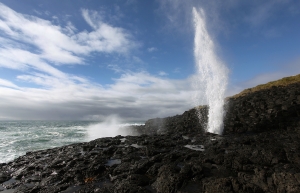
Hummanaya Blowhole, Kudawella, Sri Lanka
Sea caves along the shore can have an opening in the ground above. When waves enter the sea cave with sufficient force, water can travel upward with great pressure and escape through the opening. This can be somewhat like the blowhole of a whale coming to the surface for air and blowing out water to clear the airway.
A blowhole can also refer to an opening in the ground that is part of an underground system of caverns far from any body of water. A difference in pressure can cause air to escape from the hole.
Sea caves can grow when exposed to wave action. Sometimes a portion of the cave can grow upward until it creates an opening in the ground above. Lava flows can also create openings in the ground that extend seaward.
Blowholes that produce seawater are close to the ocean in a few various locations around the world. They are not commonly found in most areas of coastline.
Nakalele Point, Maui Island, Hawaii, USA
Hummanaya Blowhole, Kudawella, Sri Lanka
Alofaaga Blowholes, Palauli District, Savai’i Island, Samoa
A blowhole exists on the island of Maui at Nakelele Point in Hawaii. Water can reach as high as 100 feet from the pressure generated when waves are strong. Several people have died when they were sucked in or fell into the blowhole as water returns again.
The second largest blowhole in the world, called Hummanaya, exists in a small fishing village of Sri Lanka. It generates a beautiful fountain of water as large waves come crashing in, sometimes reaching almost 100 feet in height. The Alofaaga Blowholes were created by lava flows on the island of Savai’i in Samoa.
An opening in the ground connected to a cave or other opening that is exposed to strong waves, creating water pressure to produce fountains of water escaping upward through the hole
or
An opening in the ground connected to an underground system of caverns, producing air pressure that escapes upward through the hole.
We want pictures and location of the lanforms around the world and we need your help. Click get started button below.
In Asia, China, India, Nepal, and Bhutan are home to one of the eight wonders of the world and one of the most beautiful mountains in the world, the Himalaya Mountains also called the Himalayas. Boasting as the world’s highest and most famous mountain peak, Mt. Everest. Within the verse of the ‘Kumarsambhava’, Sanskrit […]
Nature have provided us with fascinating landforms and features. The most often adored landforms are volcanoes. Like the perfect cone structure of Mayon Volcano in the Philippines or Mount Fiji in Japan, people look at their beauty and wonder with great appreciation to nature. Volcanoes are mountains with a very disastrous nature. Their only […]
Taal Volcano is the second most active volcano found in the province of Batangas. A complex volcano in the middle of Taal Lake and is often called an island within a lake, that is an island within a lake that is on an island as well as one of the lowest volcano in the […]
Mayon Volcano is one of the active volcanoes in the Philippines. Located in the southern part of Luzon about 473 kilometers (294 miles) from Makati Business District of the Philippines, Mount Mayon is the main landmark of the Province of Albay of Bicol Region. According to local folklore, the volcano was named after Daragang […]
The global temperature and weather is to a large extent a direct result of the sun’s effect to our planet. Together with the atmosphere and the rotation of the earth on its axis. The earth on which weather moves on has its own effect on the weather. The different landforms like mountains, volcanoes, plains, and the […]